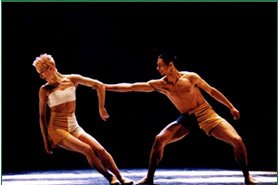Stuttgart makes high culture affordable and accessible to students. Pay only 7.90€ for a 63€ seat when you produce a student card - even one that reads in Malay, “Pelajar Universiti Malaya”. That’s subsidy for art education.
Sitting only four rows from the orchestra pit, Break-a-Leg got a good view of the performance but struggles with the German programme….
Works by 3 choreographers for the city’s ballet were performed – Mauro Bigonzetti (Kazimir’s Colours), Wayne McGregor (Eden) and Uwe Scholz (Siebte Sinfone). Tutus were banned in all three works.
Kazimir’s Colours
 (Pix Source)
(Pix Source)Stuttgart’s Corps de Ballet opened with Kazimir’s Colours, choreographed by Mauro Bigonzetti to the Concerto for Piano, Trumpet and Orchestra by Dmitri Shostakovitch.
The delightful costumes - square-patched multicoloured jackets and shorts - certainly hinted of Kazimir Malevich’s (1878-1935) movement.
Malevich was born in Kiev, Ukraine (under the Russian Empire). He introduced ‘Suprematism’ or, ‘supremacy of forms’, a study in “abstract” forms conceived in itself – non-objective and not related to anything except geometric shapes and colours. Suprematism sought to “liberate art from the ballast of the representational world.” It consisted of geometrical shapes flatly painted on the pure canvas surface.
Pas de deux formed the crux of this choreography for its 5 pairs of dancers. Though the dance does not have a storyline proper, Bigonzetti exploited the partnering technique to include some loose drama and humour into his choreography.
But the drama carried out by the lead pair, Bridget Breiner and Alexander Zaitsev at once denounces the essence of pas de deux where both dancers submit to cooperation. Either partner was unable to or refuses to accept the other. Was this a deliberate move so as to liberate dancers from the rules and techniques in the ballet world?
But as far as a duet goes, Breiner was confident, precise and technically sound, and Zaitsev, a strong partner.
Eden
{In the ‘new’ beginning…there was Dolly….}
McGregor sends a strong message of protest against cloning; against Man playing God. He said, “In this 20th century, religious thinking has been abandoned for secularism.” Indeed, it was a religious war for him.
A soloist, donned in white, animated ‘Dolly’. Her skin looked almost foetal-translucent under the dim stage lights. A single parched white tree stood at the centre of the backdrop. A platform-only elevator in front of the tree brings up Dolly-2, Dolly-3, and Dolly-n, at an alarmingly fast pace; the duplication process was smooth and quick. The ‘mass-produced’ dancers remained cold and emotionless, as they moved, almost robotic on the stage.
{The human body is limited. We need to upgrade.}
As advancements in technology fine-tune the clones, they look and behave increasingly human (now with clothes on and hair let down). The dancers were moving restlessly and constantly and they exhibited a kind of aggression in their demeanour.
McGregor pulled out all sorts of tricks from his technology hat. Stage technology, video art installations, lights and sound effects all augur ‘the future’ well. The music was urgent, intense and repetitive. But after a while, it was tiring to hear.
The on-going narrative (voice-over) was exciting – on the plus side, it tells us what the dance doesn’t; on the minus side, it tells us what the dance already does.
The concluding narrative packs a punch. The voice of a mother asking her baby ‘How was your day?’ and the baby in reply muttering something unintelligible, makes one wonder – is the baby real or an engineered one?
{The Prophet Jeremiah decided to build an artificial man.
He was perfect; was able to talk. Immediately he talked to Jeremiah:
“What did you do?”
“Well, look, I have succeeded.”
“No, no, no, it is no good.”
“From now on, when people meet other people in the street,
they will not know whether you made them or God made them.”
“Undo me.”
So that’s what Jeremiah did.}
Siebte Sinfone
“I would happily like to be considered as something of Cranko plus a little of Balanchine spat out a quarter of a century later.”
Siebte Sinfone, a classical contemporary dance, was the most ‘ballet-ish’ of the three. This ensemble item first created by Scholz for Stuttgart Ballet in 1991, had no intention for drama. It was simply pure dance and music. In fact, he seemed to be writing dance movements to Beethoven’s Sinfonie Nr. 7 A-Dur.
This skill of eurhythmics requires from the choreographer knowledge of dance as well as an astute understanding of music. Scholz seemed to have the gift for both. This treatment, which I have only read about but never seen, now danced before my eyes. Scholz visualises the score so well that the spectators could almost look into Beethoven’s mind. On stage, the ‘notes’ are dancing!
The set design was breathtaking – the backdrop was a huge white canvas with colours cascading from either side (looks like a modern art piece I saw at New York’s Metropolitan Museum in August this year). At the canvas’ centre opens an entrance for the dancers’ entry and exit.
As if the dancers in grey-white leotards were an extension of the painting, strokes of colours seem to spill off the canvas to coil around the dancers’ necks.
The male dancers, clad in grey bodysuits, looked somewhat like disciplined officers from a scene of Star Trek. True enough, Scholz’s composition requires disciplined and exceptional musicality of its dancers.
Unfortunately, the overall effect of this dance was marred by the lead ballerina, Diana Martinez Morales, who was obviously out of time and was not very confident of her steps. Playing the lead gives one the right to be different, but not the right to be indifferent to the metronome.
 (Pix Source)
(Pix Source)(German choreographer Uwe Scholz died on 21 November 2004 at the age of 46)

No comments:
Post a Comment